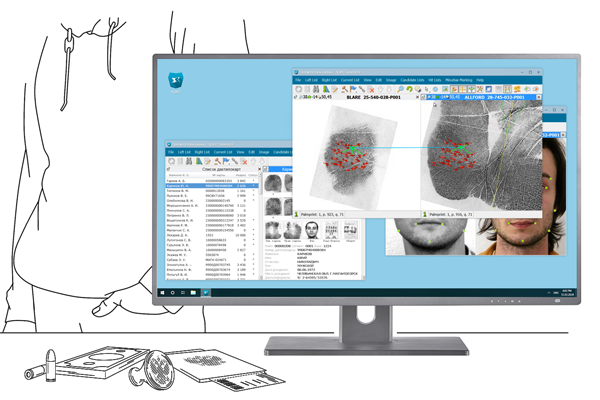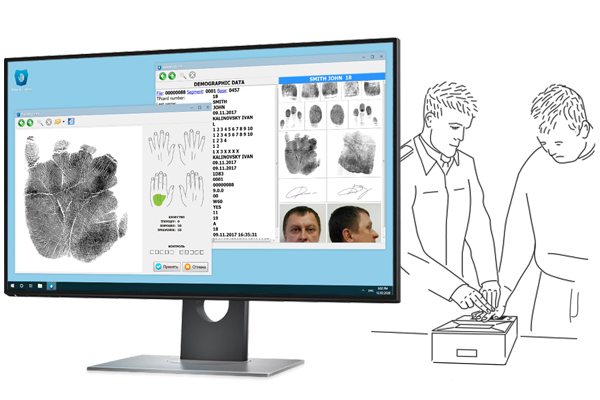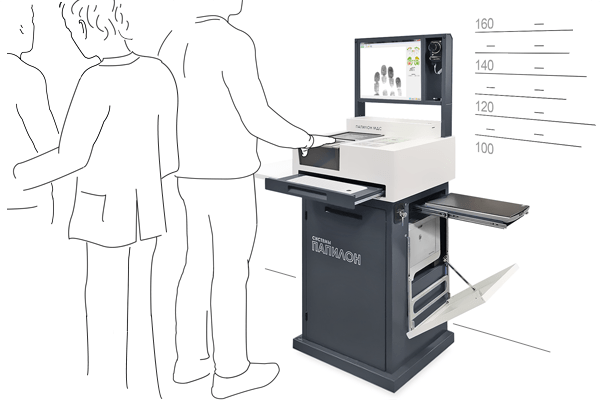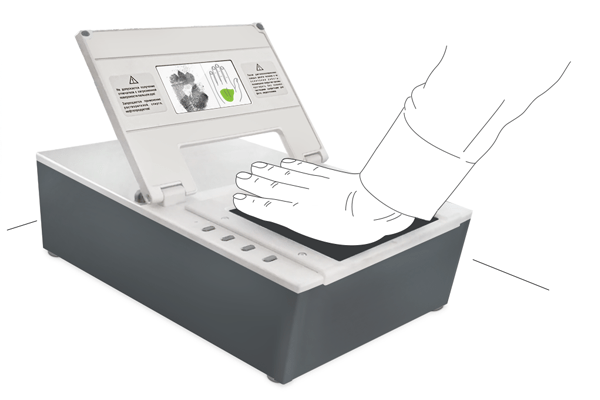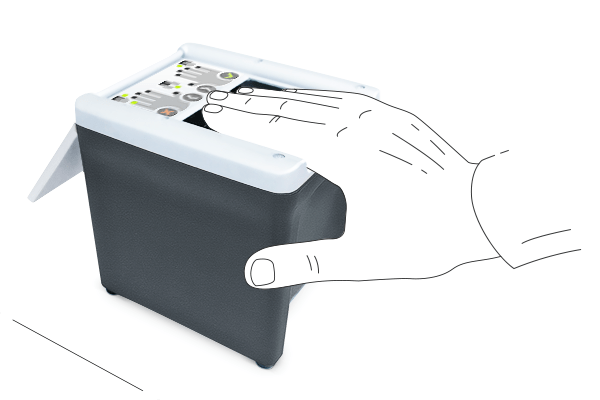Antecedentes y tareas
La historia del registro dactiloscópico en Rusia se remonta a diciembre de 1906. Las investigaciones teóricas sobre la posibilidad de automatizar los registros dactiloscópicos comenzaron en la década de 1950, bajo la dirección del Ministerio del Interior de la URSS. A partir de los años setenta, las investigaciones se concentraron en el Centro Principal de Información del Ministerio. En los años 90, el trabajo del Ministerio del Interior de Rusia, enfocado en el desarrollo e implementación del SAID (AFIS), tuvo éxito en una serie de etapas:
- impulsar el desarrollo de varios SAID (AFIS) nacionales funcionales
- implementación práctica de diversos SAID (AFIS) en cientos de departamentos forenses; acumulación de experiencia en pruebas y comparaciones de sistemas utilizando conjuntos dactiloscópicos reales
- selección del SAID (AFIS) más efectivo y prometedor
- verificación del sistema seleccionado en proyectos de automatización de registros dactiloscópicos regionales e interregionales, demostrando la eficacia de las verificaciones dactiloscópicas interregionales para resolver delitos de naturaleza migratoria, crímenes en serie y para identificar cadáveres desconocidos
- adaptación de la tecnología seleccionada para la automatización a gran escala de registros dactiloscópicos multimillonarios en los órganos de asuntos internos de Rusia
En 2002, se iniciaron los trabajos para el desarrollo del SAID (AFIS) federal y los sistemas interregionales, con el objetivo de su implementación completa en todas las regiones de la Federación de Rusia, utilizando una sola tecnología, una sola plataforma de hardware y software, y un solo formato de bases de datos. Para cumplir estas metas, fue elegida la tecnología SAID (AFIS) PAPILLON.
Tareas:
- Automatización de registros dactiloscópicos en todos los niveles de los órganos de asuntos internos de Rusia; el uso compartido de la información (registro, procesamiento de solicitudes de identificación/confirmación de identidad, verificación de huellas palmares para la investigación y resolución de delitos).
- Conversión de las fichas dactiloscópicas y las huellas latentes de escenas de crímenes no resueltos, acumuladas en centros de información y centros forenses, al formato electrónico.
- Creación de un SAID (AFIS) multinivel (regional, interregional, federal), garantizando la interacción internivel e interregional para la identificación de personas, la verificación de la participación en delitos y la actualización de las bases de datos.
- Implementación generalizada de la tecnología de dactiloscopia digital para formar y actualizar conjuntos de fichas dactiloscópicas.
- Implementación extendida de la tecnología de verificaciones rápidas en bases de datos del SAID (AFIS) en tiempo real para identificar/conformar la identidad.
Trabajo realizado
Se han llevado a cabo estudios preliminares y trabajos de ingeniería y exploración a gran escala. Se completaron las obras de construcción y montaje para preparar las instalaciones del Ministerio del Interior y de las Direcciones de Asuntos Internos republicanas y regionales para la implementación del SAID (AFIS).
Entre los años 2002 y 2011, se suministraron, montaron y pusieron en marcha el software y el hardware del SAID (AFIS). Como resultado, se creó un SAID (AFIS) multinivel, compuesto por 82 complejos:
- El SAID (AFIS) a nivel federal (80 millones de fichas dactiloscópicas)
- 10 SAID (AFIS) a nivel interregional (bases de datos de entre 3 y 10 millones de fichas dactiloscópicas)
- 71 SAID (AFIS) a nivel regional (bases de datos de entre 150 miles y 3 millones de fichas dactiloscópicas)
Puestos en marcha:
- 1.016 estaciones de trabajo de operadores en los centros regionales
- 1.223 estaciones locales del SAID (AFIS) que interactúan con los SAID (AFIS) regionales
- 1,264 estaciones de dactiloscopia y verificaciones rápidas (MDS) que interactúan con los SAID (AFIS) regionales
Se automatizaron todos los tipos de registros dactiloscópicos de los órganos de asuntos internos. Se convirtieron al formato electrónico todos los conjuntos de fichas dactiloscópicas y huellas latentes en papel de los Centros de Información y de los Centros de Ciencias Forenses.
Se generaron las siguientes bases de datos de fichas dactiloscópicas:
- 155 millones de fichas dactiloscópicas
- 4 millones de huellas dactilares latentes
- 1 millón de huellas palmares latentes
Ahora se puede procesar diariamente la siguiente cantidad de información dactiloscópica:
- 50.000 fichas dactiloscópicas
- 3.000 huellas dactilares latentes
- 800 huellas palmares latentes
Se organizaron cursos de capacitación del personal calificado para operar el SAID (AFIS):
- 4.865 operadores del SAID (AFIS)
- 685 administradores del SAID (AFIS)
- 1.520 operadores de estaciones de dactiloscopia y verificaciones rápidas
Para garantizar un funcionamiento ininterrumpido de los complejos del SAID (AFIS):
- Papillon ofrece soporte técnico y mantenimiento postventa de los sistemas
- Los especialistas de Papillon están de servicio continuo en las instalaciones con los SAID (AFIS) interregionales y federales
- Una línea telefónica directa y multicanal está disponible de forma permanente
Plan estructural de la solución
Calcular una solución equivalente
Productos utilizados
Resultados y efecto
La implementación del SAID (AFIS)-MVD permitió:
- aumento significativo de la eficacia en el uso de los registros dactiloscópicos
- reducción del tiempo dedicado a la investigación y resolución de delitos
- mantenimiento de registros dactiloscópicos en formato digital, lo que se alinea con la tendencia nacional de transición a la gestión electrónica de documentos
- uso extendido de la tecnología de identificación automática y rápida en tiempo real
- integración del SAID (AFIS)-MVD con los SAID (AFIS) de otras instituciones y agencias
El uso del SAID (AFIS) permite al Ministerio del Interior identificar anualmente:
- más de 200.000 personas con identidades falsas
- aproximadamente 15.000 cadáveres desconocidos
- aproximadamente 120.000 huellas palmares relacionadas con delitos no resueltos
En muchos casos, el SAID (AFIS) permite identificar a personas involucradas en delitos «en caliente», y así detectar rápidamente a sospechosos y minimizar los costos de investigación operativa de las agencias del orden público. El efecto económico del uso del SAID (AFIS) por el Ministerio del Interior, solo en términos de reducción de estos costos, es de aproximadamente 10.000 millones de rublos al año, sin tener en cuenta el impacto económico y social derivado de la disminución de la delincuencia y la aplicación del principio de la inevitabilidad del castigo como función preventiva para evitar nuevos delitos.




